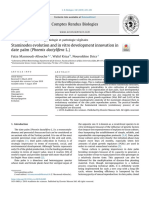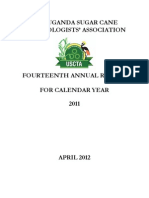Class Musci
Class Musci
Uploaded by
Elaine BriososCopyright:
Available Formats
Class Musci
Class Musci
Uploaded by
Elaine BriososOriginal Description:
Copyright
Available Formats
Share this document
Did you find this document useful?
Is this content inappropriate?
Copyright:
Available Formats
Class Musci
Class Musci
Uploaded by
Elaine BriososCopyright:
Available Formats
Class Musci
Mosses
STRUCTURES
Mosses are anchored in the soil with
thin rhizoids .
Moss leaves usually consist of a
single cell layer and are traversed
by a midrib that is always more
than one cell in thickness.
The margins of the leaves are often
toothed, the teeth pointed or
rounded.
The sporophytes of mosses, like those of the
liverworts, consist of a foot, seta and capsule
and remain permanently attached to the
gametophytes. They are borne at the tips of
erect gametophytes (a) or the tips of the
short lateral branches of prostrate
gametophytes (b).
During the early stages of
development, the sporophyte
is completely surrounded by a
tough protective covering
called the calyptra.
The peristome teeth are
perhaps the most
characteristic feature of the
mosses; usually composed of
cell wall remnants, they
respond to changes in the
humidity of the atmosphere.
Under suitable conditions,
a spore will germinate and
give rise to a microscopic
chlorophyllous branched
filament from which,
eventually, the leafy
gametophytes will arise.
The gametophyte
generation of the mosses
is, thus, dimorphic.
The moss usually illustrated in
introductory botany textbooks is
Polytrichum.
The gametophytes and
sporophytes, although devoid of
xylem and phloem, contain water-
and food-conducting cells
analogous to those of vascular
plants.
The gametophytes and
sporophytes, although
devoid of xylem and
phloem, contain water-
and food-conducting cells
analogous to those of
vascular plants.
The mouth of the capsule
is covered by a
membrane that is
overarched by massive
multicellular peristome
teeth the tips of which
are joined to the
membrane.
REPRODUCTION
The life cycle begins with two mature
gametophytes.
Females develop Archegonia and males
develop Antheridia which produce gametes by
mitosis.
The sperm is flagellated and needs water to
get to the egg.
The sporophyte is very small and dependent
on the gametophyte.
Note:
With the exeception of when the
sporangium produces spores (Meiois),
cell divisions in the entire life cycle of
the mosses are Mitotic.
The cells are Haploid (1N) throughout
the Gametophyte generation. (From
spore to mature Gametophyte)
The cells are Diploid (2N) throughout
the Sporophyte generation. (Zygote to
Sporophyte)
HABITATS AND
DISTRIBUTION
HABITAT
Mosses have a damp environment in w/c to
grow, & a surrounding of liquid water to
reproduce.
Mosses are autotrophic they require enough
sunlight to conduct photosynthesis.
Mosses grow chiefly in areas of dampness and
shade, such as wooded areas and at the edges
of stream; but they can grow anywhere in cool
damp cloudy climates, and somes species are
adapted to sunny, seasonally dry areas
likealpinerocks os stabilized sand dunes.
Moss species can be classed as growing on:
rocks, exposed mineral soil, disturbed soil,
calcareous soil, cliff seeps and etc.
Mosses often grow on trees as epiphytes, they
are never parasitic parasitic on the tree.
Mosses are also found in cracks between paving
stones in damp city streets, and on roofs. Some
species adapted to disturbed, sunny areas are
well adapted to urban conditions and are
commonly found in cities. Examples would be
Rhytidiadelphus squarrosus, a garden weed
in Vancouver and Seattle areas; Bryum
argenteum, the cosmopolitan sidewalk moss,
and Ceratodon purpureus, red roof moss,
another cosmopolitan species.
DISTRIBUTION
Bryophytes are distributed throughout
the world, from polar and alpine regions
to the tropics.
Water must, at some point, be present in the
habitat in order for the sperm to swim to the
egg. Bryophytes do not live in extremely arid
sites or in seawater, although some are found
in perennially damp environments within arid
regions and a few are found on seashores
above the intertidal zone.
The greatest diversity is at tropical and
subtropical latitudes. Bryophytes
(especially the moss
dominate the of peatland in
extensive areas of the cooler parts of the
Northern Hemisphere.
The distribution of some bryophytes,
however, is extremely restricted, yet they
possess the same apparent dispersibility
and ecological plasticity as do widespread
bryophytes. Others show broad
interrupted patterns that are represented
also in vascular plants.
IMPORTANCE TO MAN
AND ECOLOGY
Mosses plays a vital role in the
biosphere even they are small in size.
Bryophytes cause the outer portion of
rock to slowly crumble as they grow
with lichens on rock surfaces.
Some bryophytes
like sphagnum or peat moss has
some economic importance.
COMMON
REPRESENTATIVES
is a term erroneously
applied to many different plants
( , a flowering
plant; , a red alga;
pond moss, filamentous algae; and
, a ). Mosses
are classified as the class Musci in
the division Bryophyta.
Two major groups of mosses are
recognized, (The form a
small group comprising the
genera and .)
Sphagnum often grows in dense mats in
acidic boglands.
ADVANTAGES OF MOSSES
Easy planting process
Garden and lawn beautification
Herbal applications
DISADVANTAGES OF MOSSES
Disease- Sporotrichosis is a fungal disease that
has been associated with sphagnum moss. The
disease occurs because of a fungus known as
Sporothrix schenckii.
Water Absorption- Sphagnum moss absorbs and
retains any water that comes within reach. Two
problems occur when using the moss for growing
plants. The first is that the soil stays too moist for
the plant because the sphagnum moss retains the
moisture for long periods. The second problem is
that the moss could dry out the soil around the
root system, because it has absorbed the water
from that section of soil.
Environmental Concerns
You might also like
- NACA Duct TutorialDocument38 pagesNACA Duct Tutorialzebra00100% (1)
- Intuition Activation ToolkitDocument30 pagesIntuition Activation Toolkitxxdrivexx100% (12)
- Bryophytes To Gymnosperms PDFDocument101 pagesBryophytes To Gymnosperms PDFRyan Merza100% (1)
- #5 BryophytaDocument29 pages#5 BryophytarandelNo ratings yet
- Conservation of BiodiversityDocument48 pagesConservation of BiodiversityViswa NathanNo ratings yet
- Obelia: Habitat, Structure and DiagramDocument24 pagesObelia: Habitat, Structure and DiagramSunil BundelaNo ratings yet
- Seed Size Vs Seed WeightDocument24 pagesSeed Size Vs Seed WeightAhmar LiaquatNo ratings yet
- Forests of KarnatakaDocument10 pagesForests of Karnatakasanjay kumarNo ratings yet
- Life Cycle of GnetumDocument10 pagesLife Cycle of GnetumChandan Patra100% (1)
- 5 Metzeriales PDFDocument7 pages5 Metzeriales PDFnabin sharmaNo ratings yet
- ObeliaDocument7 pagesObeliaPralex PrajapatiNo ratings yet
- MarchantiophytaDocument9 pagesMarchantiophytax456456456xNo ratings yet
- ZygopterisDocument11 pagesZygopterismanojtbgri5793No ratings yet
- SphenophyllumDocument11 pagesSphenophyllummanojtbgri5793No ratings yet
- Chapman System of ClassificationDocument6 pagesChapman System of Classificationvineetvishal73No ratings yet
- CYANOPHYTADocument7 pagesCYANOPHYTAWicaksono AgungNo ratings yet
- Stucture and Life Cycle of RhizopusDocument6 pagesStucture and Life Cycle of Rhizopusabinashdash012100% (1)
- Albugo: White Rust of CrucifersDocument34 pagesAlbugo: White Rust of CrucifersMuhammad MushtaqNo ratings yet
- Bot 101 - PteridophytesDocument19 pagesBot 101 - PteridophytesnwandoanazorNo ratings yet
- Chlorophyceae: VolvoxDocument13 pagesChlorophyceae: VolvoxAnilNo ratings yet
- Secondary Growth in Dicot StemDocument22 pagesSecondary Growth in Dicot Stemfastandthecurious2161No ratings yet
- CHLAMYDOMONASDocument25 pagesCHLAMYDOMONASNavyashree R NNo ratings yet
- Boundaries of EcosystemDocument7 pagesBoundaries of EcosystemUj Umar0% (1)
- Sunflower 2Document20 pagesSunflower 2Aastha DubeyNo ratings yet
- Parental Care in Birds and MammlesDocument18 pagesParental Care in Birds and MammlesHusnain AliNo ratings yet
- Animal Kingdom by Rakshita SinghDocument82 pagesAnimal Kingdom by Rakshita Singhshakuntalagayakwad5No ratings yet
- Life Cycle of OedogoniumDocument16 pagesLife Cycle of OedogoniumMuskan Sachdeva 0047No ratings yet
- Equisetum: RamosissimumDocument7 pagesEquisetum: RamosissimumChithra VijayanNo ratings yet
- 5 Male Sterility 29-3-17Document64 pages5 Male Sterility 29-3-17Aizaz AliNo ratings yet
- Anthoceros ANTHOCEROS (Hornwort) : Morphology of ThallusDocument3 pagesAnthoceros ANTHOCEROS (Hornwort) : Morphology of ThallusyeateshwarriorNo ratings yet
- Cytotaxonomy/ Cytological: Study of Nucleus and CytoplasmDocument5 pagesCytotaxonomy/ Cytological: Study of Nucleus and CytoplasmHitesh PandeyNo ratings yet
- Punam Jaiswal PG-I Sem Classification of PteridophytesDocument5 pagesPunam Jaiswal PG-I Sem Classification of PteridophytesJerbie LlorinNo ratings yet
- Occurrence of CharaDocument12 pagesOccurrence of CharaPunam Tamang100% (1)
- Aquatic Plants AdaptDocument2 pagesAquatic Plants AdaptKrystallane ManansalaNo ratings yet
- Crustaceae Larval Forms PDFDocument12 pagesCrustaceae Larval Forms PDFAfridi ShaikhNo ratings yet
- Dr. Maneesha Singh Assistant Professor, Department of Life Sciences SGRRITS, Patel Nagar, Dehradun, UKDocument28 pagesDr. Maneesha Singh Assistant Professor, Department of Life Sciences SGRRITS, Patel Nagar, Dehradun, UKN Ganapathi KumarNo ratings yet
- Semester-1-Obelia StructureDocument8 pagesSemester-1-Obelia Structuremrinal.lm10No ratings yet
- Introduction To Entomology: Definition-The Scientific Study of InsectsDocument25 pagesIntroduction To Entomology: Definition-The Scientific Study of Insectssadam hussainNo ratings yet
- Comparative Anotomy of Respiratory SystemDocument12 pagesComparative Anotomy of Respiratory SystemNarasimha MurthyNo ratings yet
- Eamcet QR Botany SR Botany 05pterisDocument4 pagesEamcet QR Botany SR Botany 05pterisRajat Kumar SabharwalNo ratings yet
- Consortium For Educational Communication: Dr. Abdul Rashid DarDocument12 pagesConsortium For Educational Communication: Dr. Abdul Rashid DarChoirunnisaNo ratings yet
- Affinities Among Petrido PhylaDocument6 pagesAffinities Among Petrido PhylaAbdul BasitNo ratings yet
- Chapter 21Document46 pagesChapter 21Quices AyingNo ratings yet
- Gymnosperm (BOT-503) by Dr. Prabha DhondiyalDocument59 pagesGymnosperm (BOT-503) by Dr. Prabha DhondiyalluckyNo ratings yet
- Wetlands and Sanctuaries ProtectionDocument37 pagesWetlands and Sanctuaries Protectionasimakanwal03No ratings yet
- Evolution of Sporophytes and Gametophytes in BryophytesDocument7 pagesEvolution of Sporophytes and Gametophytes in BryophytesKhan KhanNo ratings yet
- Sellaginella MorphologyDocument25 pagesSellaginella MorphologySanchita Kulshrestha100% (1)
- Wetlands of PakistanDocument11 pagesWetlands of Pakistanbutterfily75% (4)
- Presentation Draft: Course No.: 501 Course Title: MycologyDocument48 pagesPresentation Draft: Course No.: 501 Course Title: Mycologysidhu_agricoNo ratings yet
- Cyathodium BryoDocument13 pagesCyathodium Bryomanojtbgri5793No ratings yet
- Ecology 4, CommunityDocument45 pagesEcology 4, CommunityAnaya ChNo ratings yet
- Fins in Fishes PDFDocument33 pagesFins in Fishes PDFPuran BistaNo ratings yet
- Xerophytes Plants With Special Characteristics Such That They Can SurviveDocument3 pagesXerophytes Plants With Special Characteristics Such That They Can Survivealphabetagama71308575% (4)
- Cell Wall StructureDocument2 pagesCell Wall StructureDl Al-azizNo ratings yet
- Ex. No. 9. - Observing The Characters of Apterygota - Collembola and Thysanura and Exopterygota - Odonata, Ephemeroptera and PhasmidaDocument28 pagesEx. No. 9. - Observing The Characters of Apterygota - Collembola and Thysanura and Exopterygota - Odonata, Ephemeroptera and Phasmidaakshayaa aswanthNo ratings yet
- Class 11 Chapter 3 BryophytesDocument6 pagesClass 11 Chapter 3 BryophytesAshok KumarNo ratings yet
- LAWNDocument5 pagesLAWNM CHANDRA PRABHANo ratings yet
- Systematic, Anatomy & Development PDFDocument1 pageSystematic, Anatomy & Development PDFAhmed RazaNo ratings yet
- Chapter 1 Classification SystemsDocument18 pagesChapter 1 Classification SystemsAsadNo ratings yet
- MetamorphosisDocument110 pagesMetamorphosisShivaniNo ratings yet
- Lec4 SocialInsects TheSociety NotesDocument3 pagesLec4 SocialInsects TheSociety NotesAlexandra LvNo ratings yet
- Polytechnic University of The Philippines: AcknowledgementDocument2 pagesPolytechnic University of The Philippines: AcknowledgementElaine BriososNo ratings yet
- Polytechnic University of The Philippines Appendices: Female 272 93.8 Male 18 6.2 290 100.0Document13 pagesPolytechnic University of The Philippines Appendices: Female 272 93.8 Male 18 6.2 290 100.0Elaine BriososNo ratings yet
- (WWW - Asianovel.com) - The Legend of The Dragon King Chapter 401 - Chapter 450 PDFDocument313 pages(WWW - Asianovel.com) - The Legend of The Dragon King Chapter 401 - Chapter 450 PDFElaine BriososNo ratings yet
- CardioDocument40 pagesCardioElaine BriososNo ratings yet
- AcknwledemetnDocument1 pageAcknwledemetnElaine BriososNo ratings yet
- Budgeting July 24 - Aug 31 2017: 110 Php/day Remaining For FoodDocument3 pagesBudgeting July 24 - Aug 31 2017: 110 Php/day Remaining For FoodElaine BriososNo ratings yet
- Drug Study 2 PPHDocument3 pagesDrug Study 2 PPHElaine BriososNo ratings yet
- Drug NameDocument2 pagesDrug NameElaine BriososNo ratings yet
- ISLU Curriculum ChecklistDocument5 pagesISLU Curriculum ChecklistElaine BriososNo ratings yet
- Ed Inst. and Warnt.Document2 pagesEd Inst. and Warnt.Elaine BriososNo ratings yet
- The ID and Class SelectorsDocument1 pageThe ID and Class SelectorsElaine BriososNo ratings yet
- Comptes Rendus Biologies: Faı Za Masmoudi-Allouche, Walid Kriaa, Noureddine DriraDocument10 pagesComptes Rendus Biologies: Faı Za Masmoudi-Allouche, Walid Kriaa, Noureddine DriraSoussou PerlaNo ratings yet
- Template 1 2 CardexDocument2 pagesTemplate 1 2 CardexPearly Jane AberaNo ratings yet
- 6th and 7th International Consensus Guidelines For The Management ofDocument66 pages6th and 7th International Consensus Guidelines For The Management ofIsailop77No ratings yet
- 7 Bayesian AnalysisDocument96 pages7 Bayesian AnalysisMohammad Raihanul HasanNo ratings yet
- HPC SK Series PDFDocument11 pagesHPC SK Series PDFphuNo ratings yet
- Anglo Saxon LiteratureDocument32 pagesAnglo Saxon LiteratureAzad RahmanNo ratings yet
- m1 SuvatDocument7 pagesm1 SuvatdrkhansacademyNo ratings yet
- Forma CalibraciónDocument7 pagesForma CalibracióndeivisroseroNo ratings yet
- The 14th USCTA Annual Report 2011Document59 pagesThe 14th USCTA Annual Report 2011s.sabapathyNo ratings yet
- Examples of Introduction Paragraph With ThesisDocument5 pagesExamples of Introduction Paragraph With Thesisanaespinalpaterson100% (2)
- DBA 303: Organisational Behaviour: DR Moses Otieno 0721246929 Moses - Otieno@uonbi - Ac.keDocument96 pagesDBA 303: Organisational Behaviour: DR Moses Otieno 0721246929 Moses - Otieno@uonbi - Ac.kefatma jaffarNo ratings yet
- Hanum at PanchaDocument5 pagesHanum at PanchaMahadeva MishraNo ratings yet
- Global Banking Annual Review 2024Document27 pagesGlobal Banking Annual Review 2024enaiditNo ratings yet
- Unit 7.1Document5 pagesUnit 7.1Paloma EstebanNo ratings yet
- Vodka More Vodka 2024 23Document5 pagesVodka More Vodka 2024 23Kicki AnderssonNo ratings yet
- MJM 27 - July 23Document8 pagesMJM 27 - July 23mohnish aryanNo ratings yet
- Maritime Graduate Student Facing Difficulty Getting Employed in Maritime Companies (Chapter 1)Document13 pagesMaritime Graduate Student Facing Difficulty Getting Employed in Maritime Companies (Chapter 1)Xzie HighlightsNo ratings yet
- Ds 8104hmi STDocument1 pageDs 8104hmi STEric Baltazar FernandezNo ratings yet
- Bi-Radial® Studio Monitor: High-Frequency Horn and DriverDocument4 pagesBi-Radial® Studio Monitor: High-Frequency Horn and DriverMarc GavageNo ratings yet
- 2008 - Evolution of Interest Rate Curve - Empirical Analysis of Patterns Using Nonlinear Clustering ToolsDocument9 pages2008 - Evolution of Interest Rate Curve - Empirical Analysis of Patterns Using Nonlinear Clustering ToolsFranck DernoncourtNo ratings yet
- House of Santa: Architecture CompetitionDocument10 pagesHouse of Santa: Architecture CompetitionAhmedBIowarNo ratings yet
- Comparative Study On Breaking Wave Forces On Vertical Walls With Cantilever SurfacesDocument7 pagesComparative Study On Breaking Wave Forces On Vertical Walls With Cantilever SurfacesJose ZamoraNo ratings yet
- Sept30 EW 2Document107 pagesSept30 EW 2vijay2109No ratings yet
- Baking Tools and Equipment and Their UsesDocument2 pagesBaking Tools and Equipment and Their UsesEeyyaa0% (1)
- I - Imperial Knights ErrataDocument2 pagesI - Imperial Knights ErrataAnotherFlyGuyNo ratings yet
- Team 4 Project - Target CorporationDocument23 pagesTeam 4 Project - Target CorporationLauren ChristineNo ratings yet
- BIMA BBS RegisterDocument47 pagesBIMA BBS Registeraminamin.200029No ratings yet
- Francis Singson ED 105 MODULE 7-10Document12 pagesFrancis Singson ED 105 MODULE 7-10Edeo BatilesNo ratings yet




































































































